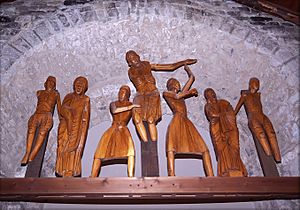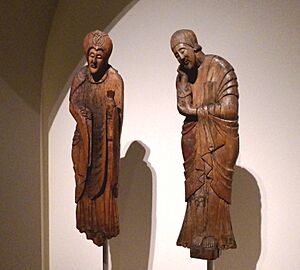Erill la Vall Descent from the Cross facts for kids
Quick facts for kids Erill la Vall Descent from the Cross |
|
|---|---|
 |
|
| Artist | Unknown |
| Year | Second half of the 12th century |
| Type | Wood carving with tempera polychrome remains |
| Location | Museu Nacional d'Art de Catalunya and Museu Episcopal de Vic, Barcelona and Vic |
The Erill la Vall Descent from the Cross is a special group of seven wooden sculptures from the 12th century. They come from a small village called Erill la Vall in the Pyrenees mountains of Catalonia, a region in Spain. These sculptures were once brightly painted. They show a scene from the Bible called the "Descent from the Cross," which is when Jesus Christ's body is taken down from the cross after his crucifixion. What makes this group unique in Catalonia is that it has seven figures. Today, two of these sculptures are kept at the National Art Museum of Catalonia (MNAC) in Barcelona, and the others are at the Vic Episcopal Museum in Vic.
What is the Erill la Vall Descent from the Cross?
This amazing group of sculptures tells a story. In the middle, the figure of Jesus Christ was held by Joseph of Arimathea. Another person, Nicodemus, was taking the nails out of Jesus's hands. On either side of Jesus were the Virgin Mary and Saint John the Evangelist. At the very ends were the two thieves who were crucified with Jesus: Dismas (the penitent, meaning he was sorry) and Gestas (the impenitent, meaning he was not sorry).
This scene, called the "Descent from the Cross," adds a more dramatic and storytelling feel to the events of Jesus Christ's final days. These sculptures were probably used in special plays or performances during the Middle Ages, which were called "liturgical dramas." The National Art Museum of Catalonia also has similar sculptures from other places in the Vall de Boí (Boí Valley), like Santa Maria de Taüll and Durro. The Boí Valley is even a UNESCO World Heritage Site!
Why is this sculpture group special?

Large wooden sculptures like the "Descent from the Cross" are very important in the history of Romanesque art in Catalonia. They are known for their high artistic quality and their unique style. Many of these special groups come from the Boí Valley.
One thing that makes these Catalan sculptures different from others is that they often have seven figures. As we mentioned, Jesus is in the center, supported by Joseph of Arimathea and Nicodemus. On each side are Mary and Saint John. At the very ends are the two thieves, Dismas and Gestas.
The story of the Descent from the Cross makes the events of Jesus's crucifixion feel more real and dramatic. This might be why they were used in religious plays at the time. Some historians also think that these groups in Catalonia during the 12th and 13th centuries helped teach about important Christian beliefs. They could have shown the meaning of Christ's death and the Eucharist (a Christian ceremony), especially when some groups had different ideas about these faiths.
The Erill la Vall Descent is the most complete group of its kind from the western Pyrenees in Catalonia. However, all the figures are not always shown together. They are split between the Vic Episcopal Museum and the Museu Nacional d'Art de Catalunya. Sometimes, these museums lend the sculptures to each other so they can be displayed as a full set.
Overall, this group is a masterpiece of Romanesque carving in Catalonia. It is so important that other similar artworks, like the Descent from Santa Maria de Taüll and what is left of the one from Durro, are often compared to it. Other types of art, like altar frontals (decorated fronts of altars) and crucifixes, are also studied alongside it.
See also
 In Spanish: Descendimiento de Erill la Vall para niños
In Spanish: Descendimiento de Erill la Vall para niños

